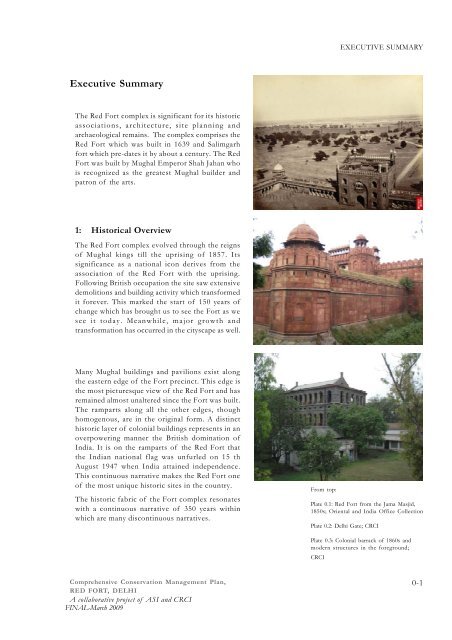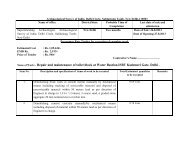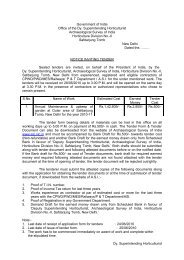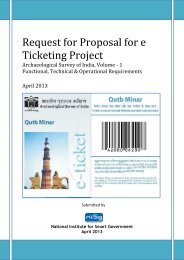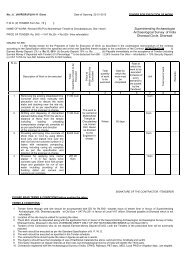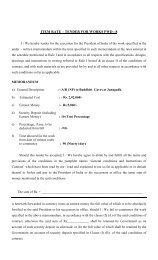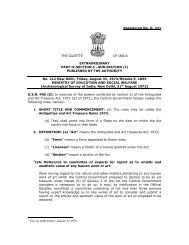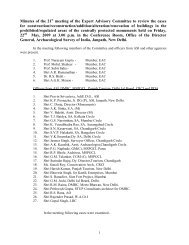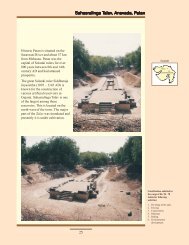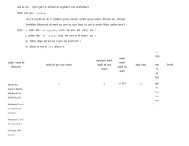Executive Summary - Archaeological Survey of India
Executive Summary - Archaeological Survey of India
Executive Summary - Archaeological Survey of India
You also want an ePaper? Increase the reach of your titles
YUMPU automatically turns print PDFs into web optimized ePapers that Google loves.
<strong>Executive</strong> <strong>Summary</strong><br />
The Red Fort complex is significant for its historic<br />
associations, architecture, site planning and<br />
archaeological remains. The complex comprises the<br />
Red Fort which was built in 1639 and Salimgarh<br />
fort which pre-dates it by about a century. The Red<br />
Fort was built by Mughal Emperor Shah Jahan who<br />
is recognized as the greatest Mughal builder and<br />
patron <strong>of</strong> the arts.<br />
1: Historical Overview<br />
The Red Fort complex evolved through the reigns<br />
<strong>of</strong> Mughal kings till the uprising <strong>of</strong> 1857. Its<br />
significance as a national icon derives from the<br />
association <strong>of</strong> the Red Fort with the uprising.<br />
Following British occupation the site saw extensive<br />
demolitions and building activity which transformed<br />
it forever. This marked the start <strong>of</strong> 150 years <strong>of</strong><br />
change which has brought us to see the Fort as we<br />
see it today. Meanwhile, major growth and<br />
transformation has occurred in the cityscape as well.<br />
Many Mughal buildings and pavilions exist along<br />
the eastern edge <strong>of</strong> the Fort precinct. This edge is<br />
the most picturesque view <strong>of</strong> the Red Fort and has<br />
remained almost unaltered since the Fort was built.<br />
The ramparts along all the other edges, though<br />
homogenous, are in the original form. A distinct<br />
historic layer <strong>of</strong> colonial buildings represents in an<br />
overpowering manner the British domination <strong>of</strong><br />
<strong>India</strong>. It is on the ramparts <strong>of</strong> the Red Fort that<br />
the <strong>India</strong>n national flag was unfurled on 15 th<br />
August 1947 when <strong>India</strong> attained independence.<br />
This continuous narrative makes the Red Fort one<br />
<strong>of</strong> the most unique historic sites in the country.<br />
The historic fabric <strong>of</strong> the Fort complex resonates<br />
with a continuous narrative <strong>of</strong> 350 years within<br />
which are many discontinuous narratives.<br />
Comprehensive Conservation Management Plan,<br />
RED FORT, DELHI<br />
A collaborative project <strong>of</strong> ASI and CRCI<br />
FINAL-March 2009<br />
From top:<br />
EXECUTIVE SUMMARY<br />
Plate 0.1: Red Fort from the Jama Masjid,<br />
1850s; Oriental and <strong>India</strong> Office Collection<br />
Plate 0.2: Delhi Gate; CRCI<br />
Plate 0.3: Colonial barrack <strong>of</strong> 1860s and<br />
modern structures in the foreground;<br />
CRCI<br />
0-1


